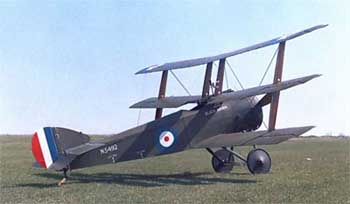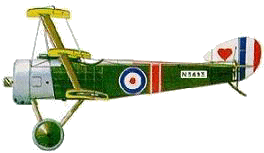|

Sopwith Triplane


In their search for an outstanding fighting
aeroplane the Sopwith experimental department decided in early 1916 to
build an entirely new design--a triplane. The completed machine had three
narrow-chord wings. The combined wing area of the three mainplanes gave
the aircraft plenty of lift. Ailerons were fitted to all three wings; the
interplane struts were plain but strong and few bracing wires were needed.
The fuselage was a typical Sopwith wooden box girder. Tail- plane,
elevators, rudder and fin resembled those of the Pup, but later production
models had a tail-plane of reduced area. The handling qualities of the
Triplane were excellent. It is now regarded as only slightly less
manoeuvrable than the Pup, but many pilots preferred it to the little
biplane.

The triplane layout was adopted in order to give the pilot the widest
possible field of vision, and to ensure manoeuvrability. Shown here is the
prototype Triplane N.500 at Chingford
The triplane layout was adopted in order to
give the pilot the widest possible field of vision, and to ensure
manoeuvrability. The central wing was level with the pilot's eyes and
obscured very little of his view, and the narrow chord of all the
mainplanes ensured that the top and bottom wings interfered less with his
outlook than the wings of a biplane. The narrow chord aided
manoeuvrability, for the shift of the centre of pressure with changes of
incidence was comparatively small; this permitted the use of a short
fuselage. At the same time, the distribution of the wing area over three
mainplanes kept the span short and conferred a high rate of roll.

Clayton and Shuttleworth-built Triplane flown by No. I Squadron, R.N.A.S.
Looking back, it is hard to realize the
revolutionary nature of the Triplane at the time it appeared. Nothing
quite like it had ever been built for military purposes, and the best
measure of its success is provided by the profusion of German and Austrian
single-seat fighter triplanes which appeared after the impact made by the
Sopwith Triplane
It has been said that Anthony Fokker was so anxious to produce an aircraft
which would be an adequate reply to the new Sopwith fighter that he
resorted to subterfuge to obtain an example of the Triplane. He contrived
to arrange for the delivery to his works of the remains of a Sopwith
Triplane which had been shot down, despite the fact that the aircraft
should have gone to the German experimental field at Adlershof. However,
the Fokker Dr. I Triplane which was ultimately designed by Reinhold Platz,
Fokker's chief designer, was a very different aeroplane from the Sopwith
Triplane.
The power unit, a 110 h.p. Clerget rotary, was eventually replaced by the
130 h.p. Clerget. The standard armament consisted of a fixed Vickers gun,
synchronized to fire through the revolving propeller. A small batch of six
Triplanes, however, were fitted with twin Vickers guns built by Clayton &
Shuttleworth.
The first prototype Sopwith Triplane, N.500, went to France in mid-June,
1916 to undergo Service trials with Naval "A" Fighting Squadron at Furnes.
The Triplane was an instant success, and no time was lost in testing it in
action, for it was sent up on an interception within a quarter of an hour
of its arrival at Furnes. It was destined to be flown operationally by
naval units only. The R.F.C., who had already received a present of the
first sixty R.N.A.S. Spad S.7s, decided in February 1917 to accept the
remaining sixty in exchange for the Sopwith Triplanes on order for the
Corps.

Clayton and Shuttleworth-built
Triplane flown by No. I Squadron, R.N.A.S.
The type was ordered by the Admiralty for the
R.N.A.S., and the War office followed suit by ordering 266 machines for
the R.F.C. Sopwith built the R.N.A.S. Triplanes. Other contractors
undertook production of the Triplane for the R.F.C.
No. 1 (Naval) Squadron, 'Naval one', went into action with the type in
April 1917, in support of the hard-pressed R.F.C. The hitherto very
successful Albatros D-III was completely outclassed, and IdFlieg , the
German Inspectorate of Flying Troops, received a severe shock. The
Tripehound could out-climb and out-turn the Albatros, and was 15 m.p.h
faster. Naval Eight and Naval Ten, equipped in April and May, also made
their presence felt. Proof of the Triplane's worth was soon to be shown.
In April 1917 Flight Commander R. S. Dallas and Flight Sub-Lieutenant T.
G. Culling attacked a formation of fourteen German aircraft. After
forty-five minutes they had shot down three of the enemy and driven the
remainder into retreat.
On June 6th, thirteen of Naval Ten's Triplanes fought fifteen enemy
aeroplanes and shot down five without loss to themselves. Two of the five
were Albatros scouts which fell in flames under the fire of Flight
Sub-Lieutenant Raymond Collishaw. Other famous R.N.A.S. pilots who scored
heavily with the type were Collishaw, Little, Booker, Reid, Sharman, Nash
and Alexander.
Collishaw was probably the best-known exponent of the Sopwith Triplane's
superb fighting qualities. A Canadian, he was given command of "B" Flight
of No. 10 (Naval) Squadron on April 1st, 1917. This was the famous "Black
Flight", as redoubtable a fighting unit as took the air during the war.
Between May and July, 1917 it accounted for no fewer than eighty-seven
enemy aircraft. All the pilots were Canadians. The original members were
Flight Sub-Lieutenant E. V. Reid, Flight Sub-Lieutenant J. E. Sharman,
Flight Sub-Lieutenant G. E. Nash, and Flight Sub-Lieutenant W. M.
Alexander. The Triplanes of the Black Flight were named Black Death, Black
Maria, Black Roger, Black Prince and Black Sheep.
In a combat on June 26th, 1917, Nash was wounded and forced down behind
the enemy lines by Leutnant Allmenroder, a German pilot with thirty
victories to his credit. Next day Collishaw avenged the loss of his
friend. In a fight which began near Courtrai, he shot down and killed
Allmenroder, forcing his green tailed Albatros to crash on the outskirts
of Lille.
In twenty-seven days during June, 1917, Collishaw shot down sixteen enemy
machines. All, except three, were Albatros and Halberstadt single-seat
fighters.

N.5431, at Mudros in the Aegean.
Some difficulty was found in obtaining spares
for the Triplane during the summer of 1917, and one unit, Naval one, had
to reduce its establishment from eighteen to fifteen aeroplanes. By the
autumn the type had passed its zenith and the rate of casualties in
Triplane squadrons rose.
At the end of August, 1917, No. 10 (Naval) Squadron began to re-equip with
Sopwith Camels. Three of its Triplanes were then transferred to No. I
(Naval) Squadron, which in turn gave up its beloved Triplanes on its
withdrawal on November 2nd, 1917. The first Triplane squadrons to begin
re-equipment with Camels were No. 8 (Naval), which had received a few
Camels by the end of July, 1917, and No. 9 (Naval), which exchanged its
Triplanes and Pups for Camels between mid-July and August 4th.
The Battles of Ypres were therefore the last actions over which Sopwith
Triplanes flew. They fought with distinction until their final demise.
When it is realized that only about 150 were built, it is surprising how
much they influenced the trend of design. A host of triplanes and
quadruplanes were built by the leading German and Austro-Hungarian
aircraft manufacturers in efforts to match the performance of the
remarkable Sopwith Triplane.

N.5486 serving with the Imperial
Russian Air Service
One Sopwith Triplane, N.5431, was used in
Macedonia. It was on the strength of No. 2 Wing R.N.A.S., and in March,
1917, it was allocated to the new R.N.A.S. unit known as "E" Squadron,
which later combined with a Royal Flying Corps detachment to form the
Composite Fighting Squadron, based at Hadzi Junas as a countermeasure to
the German bomber squadron then operating from Hudova. However, N.5431
never reached Hadzi Junas. It flew first to Stavros; and, in company with
four Sopwith 1 1/2 Strutters, set out for Salonika on March 26th, 1917.
Its pilot was Flight Lieutenant John Alcock. When landing at Salonika,
Alcock made one of the few errors of judgment in his distinguished flying
career. He overshot the small aerodrome and wrecked the Triplane. The
wreckage was taken back to Mudros and rebuilt. It was still flying from
Mudros at the end of September, 1917. On the 30th of that month it was
flown by Lieutenant H. T. Mellings when he shot down an enemy single-seat
fighter seaplane.
Another, 'Tripe' No. N5486, went to Russia and was eventually provided
with skis for operating in the snow.
Country: Great Britain
Manufacturer: Sopwith Aviation Company
Type: Fighter
First Introduced: November 1916
Number Built: 152
Engines: Clerget 9Z, 9 cylinder, rotary, 110 hp [82 kw]
Clerget 9B, rotary, 130 hp [96 kw]
Le Rhône, 9 cylinder, 110 hp [82 kw]
Wing Span: 26 ft 6 in [8.07 m]
Length: 18 ft 10 in [5.73 m]
Height: 10 ft 6 in [3.20 m]
Empty Weight: 1,101 lb [499 kg]
Gross Weight: 1,541 lb [698 kg]
Max Speed: 117 mph [188 km/h]
Ceiling: 20,500 ft [6,248 m]
Endurance: 2¾ hours
Crew: 1
Armament: 1 synchronized Vickers .303 machine gun
(a handful were equipped with twin machine guns)
|
